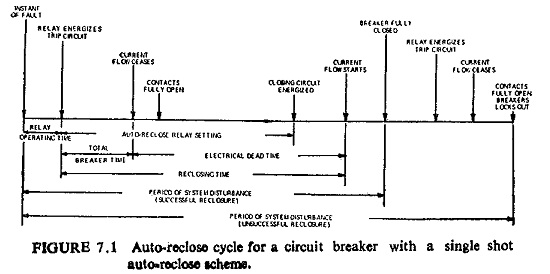Auto Reclosing Scheme:
Auto Reclosing Scheme – It is well realized that the transient faults which are most frequent in occurrence do no permanent damage to the system as they are transitory in nature. These faults disappear if the line is disconnected from the system momentarily in order to allow the are to extinguish. After The arc path has become sufficiently deionized, the line can be reclosed to restore normal service. The type of fault could be a flashover across an insulator.
Reclosing could also achieve the same thing with semi-permanent faults but with a delayed action, e.g. a small tree branch falling on the line, in which case the cause of the fault would not be removed by the immediate tripping of the circuit breaker but could be burnt away during a time delayed trip and thus the line reclosed to restore normal service. Now should the fault be permanent, reclosing is of no use, as the fault still remains on reclosing and the fault has to be attended personally. It simply means that if the fault does not disappear after the first trip and closure, double or triple-shot reclosing is used in some cases before pulling the line out of service. Experience shows that nearly 80% of the faults are cleared after the first trip, 10% stay in for the second reclosure which is made after a time delay, 3 % require the third reclosure and about 7% are permanent faults which are not cleared and result in lockout of the reclosing relay.
When a line is fed from both ends, the breakers at the two ends trip simultaneously on occurrence of the fault, the generators at the two ends of the line drift apart in phase, the breakers must be reclosed before the generators drift too far apart for synchronism to be maintained, such a reclosure increases the stability limit considerably.
In presentday power systems, Auto Reclosing Scheme finds wide application. It therefore follows that to effect fault clearance and subsequent reclosure, it is often necessary to operate sequentially several items of switchgear Recently logical design principles have been applied for the control of auto-reclose switching sequences in large substations.
Definitions and Available Features:
Operating Time of Protective Relay: Time from the inception of the fault to the closing of the tripping contacts.
Operating Tiny of Circuit Breaker: Time from the energizing of the trip coil until the fault arc is extinguished
Dead Time of Circuit Breaker or System: Time between the fault arc being extinguished and the circuit breaker contacts remaking.
Dead Time of Auto-Reclose Relay: The time between the Auto Reclosing Scheme being energized and the completion of the circuit to the circuit breaker closing contactor. On all but instantaneous or very high speed reclosing schemes this time which is normally adjustable and marked on the calibrated dial is virtually the same as the circuit breaker dead time. In multi-shot schemes the individual dead times may be the same 6r separately adjusted.
Closing Impulse Time of Auto-Reclose Relay: The time during which the closing contacts on the auto-reclose relay are made.
Reclaim time of Auto-Redoge Relay: The time from the making of the closing contacts on the auto-reclose relay to the completion of another circuit within the Auto Reclosing Scheme which will reset the scheme or lock out the scheme or circuit breaker as required. This time may be fixed or variable or dependent on the dead time setting. In the multi-shot scheme the individual reclaim time may be the same or independently adjustable.
Reclosing Time: This is the time taken by the circuit breaker to open and reclose the line and is measured from the instant of energization of the trip circuit to the instant when the breaker contacts remake the circuit. This period is made up of the circuit breaker time plus the system electrical dead
Lockout of Circuit Breakers: A feature in the Auto Reclosing Scheme to prevent further automatic closing of the circuit breaker after the chosen sequence of reclosures has been unsuccessful. From this position the circuit breaker must be reclosed manually.
Lockout of Auto-Reclose Relay: A feature in the auto-reclose scheme to prevent further automatic closing after the chosen sequence, regardless bf whether the reclosure was successful or not.
Anti-Pumping: A feature incorporated in the circuit breaker or the reclose scheme whereby, in the event of a permanent fault, repeated operation of the circuit breaker are prevented when the closing impluse is longer than the sum of the protective relay and circuit breaker operating
Number of Shots: The number of attempts at reclosing which an auto-reclose scheme will make before locking out on a permanent fault. The number of shots may be fixed or adjustable.
Spring Winding Time: On motor wound spring closed circuit breakers this is the time required for the motor to fully charge the spring after a closing operation.
Operation Counter: Usually an electromagnetically operated cyclometer type dial which is stepped round one digit each time the coil is energized. These are often incorporated in auto-reclose schemes to record the number of operations of the circuit breaker. This is necessary for maintenance purposes for in unattended substations the operations might not be logged in the usual manner.
Counting Relay: A relay usually of the electromagnetic type incorporating a ratchet arrangement which is driven forward one step each time the coil is energized. A contact is operated after a chosen number of steps and the mechanism may be manually or electrically reset.
Figure (7.1) illustrates auto-reclose cycle for a circuit breaker fitted with single shot auto-reclose scheme.
